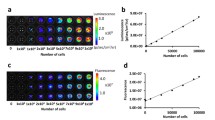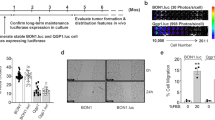Abstract
To develop effective therapeutic strategies aimed at treating tumor metastasis, critical steps in this process must be better understood. For this purpose we have established a new model to visualize and quantify early metastasis. Murine CT-26 colon adenocarcinoma cells were stably transfected with green fluorescent protein (GFP). Tumor cells were intraportally delivered to the liver of Balb/c mice and subsequently tracked by intravital fluorescence microscopy. Coinjection of fluorescent beads and in vivo propidium iodide staining allowed examination of initial tumor cell arrest, extravasation, viability and proliferation. Results showed that GFP-transfection compared to conventional labeling procedures (Calcein, cytoplasmic microspheres) did not alter early metastatic properties. However, the long-term development of liver metastases expressing GFP was markedly reduced compared to wild type CT-26 tumor cells. An increase in the size and the number of liver metastases in T- and B-cell-deficient SCID mice suggested an immune response to the GFP transfected cells responsible for the reduced metastatic growth in wild-type mice. Based on our findings, this model can be used to examine the early steps of metastasis in vivo. However, in immunocompetent mice, the use of GFP-labeled tumor cells should be limited to tracking cell arrest and extravasation, whereas evaluations of long-term metastatic growth should be performed in immunodeficient mice.
Similar content being viewed by others
References
Morris VL, MacDonald IC, Koop S et al. Early interactions of cancer cells with the microvasculature in mouse liver and muscle during hematogenous metastasis: videomicroscopic analysis [see comments]. Clin Exp Metastasis 1993; 11: 377–90.
Guba M, Bosserhoff AK, Steinbauer M, et al. Overexpression of MIA enhances extravasation and metastasis of A-mel 3 melanoma cells. Br J Cancer 2000; 83: 1216–22.
Koop S, MacDonald IC, Luzzi K et al. Fate of melanoma cells entering the microcirculation: over 80% survive and extravasate. Cancer Res 1995; 55: 2520–3.
Morris VL, Koop S, MacDonald IC et al. Mammary carcinoma cell lines of high and low metastatic potential differ not in extravasation but in subsequent migration and growth. Clin Exp Metastasis 1994; 12: 357–67.
Vajkoczy P, Schilling L, Ullrich A et al. Characterization of angiogenesis and microcirculation of high-grade glioma: An intravital multifluorescence microscopic approach in the athymic nude mouse. J Cereb Blood Flow Metab 1998; 18: 510–20.
Naumov GN, Wilson SM, MacDonald IC et al. Cellular expression of green fluorescent protein, coupled with high-resolution in vivo videomicroscopy, to monitor steps in tumor metastasis. J Cell Sci 1999; 112: 1835–42.
Li CY, Shan S, Huang Q et al. Initial stages of tumor cell-induced angiogenesis: evaluation via skin window chambers in rodent models. J Natl Cancer Inst 2000; 92: 143–7.
Huang Q, Shan S, Braun RD et al. Noninvasive visualization of tumors in rodent dorsal skin window chambers. Nat Biotechnol 1999; 17: 1033–35.
Al-Mehdi AB, Tozawa K, Fisher AB et al. Intravascular origin of metastasis from the proliferation of endothelium-attached tumor cells: a new model for metastasis. Nat Med 2000; 6: 100–2.
Luzzi KJ, MacDonald IC, Schmidt EE et al. Multistep nature of metastatic inefficiency: Dormancy of solitary cells after successful extravasation and limited survival of early micrometastases. Am J Pathol 1998; 153: 865–73.
Guba M, Cernaianu G, Jauch KW et al. primary tumor promotes dormancy of solitary tumor cells before inhibiting angiogenesis. Cancer Res 2001; 61: 5575–9.
Steinbauer M, Harris AG, Abels C et al. Characterization and prevention of phototoxic effects in intravital fluorescence microscopy in the hamster dorsal skinfold model. Langenbecks Arch Surg 2000; 385: 290–8.
Steinbauer M, Guba M, Büchner M et al. Impact of polynitroxylated albumin (PNA) and tempol on ischemia/reperfusion injury: intravital microscopic study in the dorsal skinfold chamber of the Syrian Golden hamster. Shock 2000; 14: 163–8.
Chambers AF, MacDonald IC, Schmidt EE et al. Steps in tumor metastasis: New concepts from intravital videomicroscopy mammary carcinoma cell lines of high and low metastatic potential differ not in extravasation but in subsequent migration and growth. Cancer Metastasis Rev 1994; 12: 357–67.
Guba M, von Breitenbuch P, Steinbauer M et al. Rapamycin inhibits primary and metastatic tumor growth by antiangiogenesis: Involvment of vascular endothelial growth factor. Nat Med 2002; 8: 128–35.
Asaishi K, Endrich B, Götz AE et al. Quantitative analysis of microvascular structure and function in the amelanotic melanoma A-Mel-3. Cancer Res 1981; 41: 1898–904.
Harris AG, Leiderer R, Peer F et al. Skeletal muscle microvascular and tissue injury after varying durations of ischemia. Am J Physiol 1996; 271: H2388–98.
Naumov GN, MacDonald IC, Weinmeister PM et al. Persistence of solitary mammary carcinoma cells in a secondary site: A possible contributor to dormancy. Cancer Res 2002; 62: 2162–8.
Cameron MD, Schmidt EE, Kerkvliet N et al. Temporal progression of metastasis in lung: cell survival, dormancy, and location dependence of metastatic inefficiency. Cancer Res 2000; 60: 2541–6.
Stripecke R, Carmen, Villacres M et al. Immune response to green fluorescent protein: implications for gene therapy. Gene Ther 1999; 6: 1305–12.
Brown DM, Fisher TL, Wei C et al. Tumours can act as adjuvants for humoral immunity. Immunology 2001; 102: 486–97.
Author information
Authors and Affiliations
Corresponding author
Rights and permissions
About this article
Cite this article
Steinbauer, M., Guba, M., Cernaianu, G. et al. GFP-transfected tumor cells are useful in examining early metastasis in vivo, but immune reaction precludes long-term tumor development studies in immunocompetent mice. Clin Exp Metastasis 20, 135–141 (2003). https://doi.org/10.1023/A:1022618909921
Issue Date:
DOI: https://doi.org/10.1023/A:1022618909921




